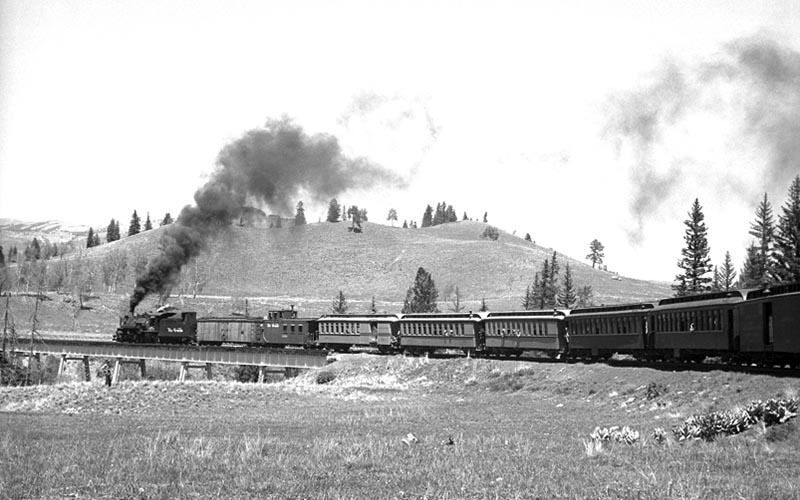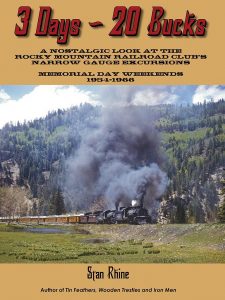Founded in 1938, the Rocky Mountain Railroad Club is known for organizing some of the greatest trips over the Colorado narrow gauge lines, and their annual Memorial Day rail excursions were legendary. In an era when railfans donned suit and tie to chase trains, carried their trusty Brownie and Speed Graphic cameras, and counted their exposures more carefully than their lunch money, a young Stan Rhine ponied up 20 bucks and joined the fun. Rubbing elbows with club members like Otto Perry, Richard Kindig, Mac Poor, and Bob Richardson, Rhine captured shots of both familiar and vanished locations on film. For the first time in print, he tells the story of these start-of-summer weekend rail jaunts. He also touches on some of the club’s other narrow gauge excursions and, as a bonus, gives us the story of the last narrow gauge passenger train movement from Alamosa. Enjoy this selection of photos from Three Days, 20 Bucks.

This photo dates from the mid-1960s. Having ridden from Alamosa to Durango the first day, the second day excursion will take club members from Durango up to Silverton. While the RMRRC’s train was serviced in Durango, club members scrambled through the yard, shooting the narrow gauge equipment. Author Rhine caught No. 484 switching cars while a fellow club member chats with a trainman.

Sublette, N.M., was a regular water stop on the narrow gauge, and remains in use today on the Cumbres & Toltec Scenic. Even the junior club members availed themselves of the photo opportunities provided by the stop during this 1963 fantrip. The “town” of Sublette consists of a few buildings for the railroad section workers and their tools, and the water stand pipe.

This is the 1954 fantrip on the Rio Grande “High Line” through Animas Cayon between Durango and Silverton, Colo. Powered by No. 476 (numbered “7” and sporting a box headlight for movie work in James Cagney’s movie Run For Cover), combine 212 and the next two coaches are also in the bright yellow paint with two black stripes from their appearance the movie Denver & Rio Grande. Eventually, all the remaining passenger equipment would be painted in the “Grande Gold” color scheme.

Day three of the 1954 fantrip finds the train eastbound crossing Lobato Trestle on the way back to Alamosa. Having already climbed 500 feet out of the Chama River valley, this trestle crosses Wolf Creek, and soon the tracks will reach 4% on the way to the 10,022-foot summit of Cumbres Pass, nine miles northeast.

None of the club members were pleased to see U.S. Army RS4TC diesel No. 4700N serving as the helper locomotive on the trip to Silverton. Dubbed the “Little Monster,” it worked out of Durango, mostly down to Farmington for about a year, and then was returned to the Army. Built in 1954, the N4700 was the only narrow gauge diesel built for an order of Transportation Corps locomotives. Capable of being gauged at 36 inches, meter, or 42 inches, the engine was tested on the D&RGW lines out of Durango. Not scrapped until 1973, the 4700N lives on infamously in photos of the 1954 trip.




